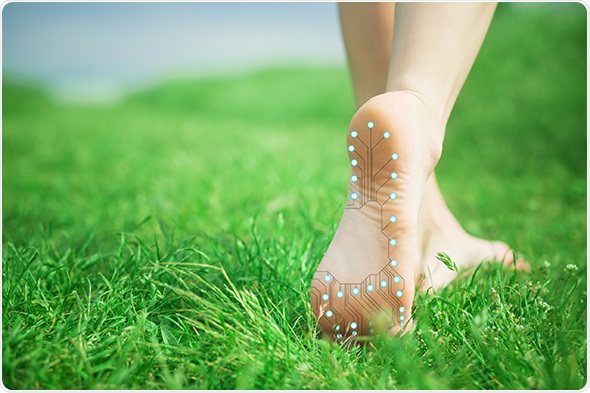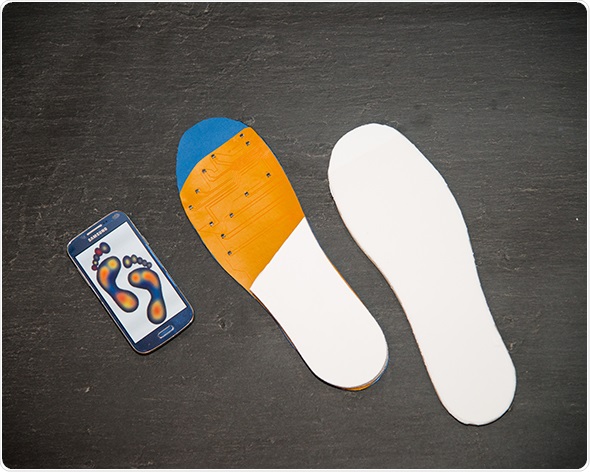It is very common for people with diabetes to suffer from nerve dysfunction in their feet causing loss of sensation. In fact, diabetic neuropathy is the most common complication of diabetes.
When people don’t receive the body’s natural signals due to neuropathy, they can unknowingly be exposing their feet to conditions that are known to cause foot ulcers, such as repeated pressure and shear.
Diabetes foot conditions can affect both those with type 1 or type 2 diabetes, because prolonged exposure to high blood sugar can damage delicate nerve fibers, along with other metabolic factors.
What problems can this inability to feel foot pain cause and how frequently does this lead to amputation?
Because they cannot feel pain, patients fail to notice small cuts, bruises or blisters developing, which can turn into ulcers and infections, so daily monitoring of feet is required.
Diabetes UK estimates such problems cost the NHS up to £700million a year and lead to around 6,000 amputations – more than 100 a week.
Diabetes UK says around 80 per cent of amputations are preventable if patients are aware of the risks and undertake an appropriate foot monitoring regime.

Could you please outline the smart insole that HCi Viocare have developed?
The Smart Insole fits into any shoe and uses a network of tiny electronic sensors to send data back to a smart device or mobile for real-time feedback or for later analysis. It can also be built directly into the shoe.
It is designed to be used for people who want to monitor the stresses and strains on their feet, such as diabetic patients, and professional or amateur athletes who want to improve performance and prevent knee injury.
It is expected to retail at around £200 and may be prescribed or reimbursed by healthcare providers to diabetic patients at risk of foot ulcers.
Flexisense Technology
How does the smart insole detect pressure across the foot?
The smart insole uses 21 tiny sensor systems, carefully configured to match key risk areas, to detect pressure and shear across the foot.
It is important to measure shear, the ‘squashing’ rather than rubbing of the skin, because it is a leading cause of pressure ulcers, and the damage does not necessarily happen in the places with the highest pressure.

What can this information be used for?
By monitoring the pressure and shear experiences of their feet in real-time, the insole can alert patients to risky behaviour or bad footwear, or if recommended thresholds of pressure over time are exceeded.
Clinical studies have shown that as long as patients are focused on their feet and have a good management regime, they can prevent ulcers without any other intervention. We want to provide that focus.
The insole is also a handy tool for blood glucose monitoring needs: it can record your activity better than wrist-worn devices, tell you your weight and give you a much more accurate reading of calories expended for you to input into your daily insulin calculations effortlessly.
What stage of development is the Smart Insole at?
HCi Viocare’s business plan is to commercialise our technology through licensing agreements with relevant manufacturers or retailers. We are currently engaging with potential licensing partners to commercialise the Smart Insole and have working prototypes.
How would you define ‘Internet of Things’ products and what impact do you think they will have on our lives over the next decade?
IoT products are those items around us that collect data and are always connected to the internet and/or smart devices. They can come in any form, whether it be in the house, the car, at work or outside.
I think there will be enormous growth of IoT devices in the next 2-3 years, but then people will begin to realise that “just because you can, doesn’t mean you should”.
It was similar during the internet bubble around 2000, when there was a big technology push, some of which didn’t take into account people’s habits and in the end did not provide real value.
But eventually the IoT devices will be ubiquitous and whilst privacy concerns will be at the forefront of our minds (and we try to avoid a ‘Minority Report’ type world), the measurements taken by devices will be of immeasurable value.
I think this is true particularly in health, where prevention and disease monitoring will help manage diseases, and in safety, where lives will be saved because of smart cars, smart electrical cables, smart baby beds, you name it.
What impact do you think the Smart Insole could have on diabetes patients?
One third of the estimated 3.7million diabetes sufferers in the UK will develop problems such as ulcers, gangrene, infections and deformities because the condition means they lose feeling in their feet.
The NHS in England spends £600m per year on diabetic foot complications. This could almost completely disappear if diabetics with even the slightest indication of neuropathy would monitor their feet with our insole.
People who have a predisposition to ulceration can be alerted through the insole when they are exhibiting risky behaviour so that they stop in time.
More positively, we may also be able to reassure some diabetics that exercising with a particular training shoe is OK, which could have a real impact on their overall health.
What are HCi Viocare’s plans for the future?
The sensor technology in the Smart Insole can be used in many different products and we are looking to commercialise some of them with partners in the different sectors.
In the healthcare sector, we are developing a Smart Mattress and Smart Wheelchair Cushion which will use the same electronic sensors to monitor potentially harmful pressure among bedridden or wheelchair-bound patients.
However, this is not just about monitoring it is about prevention as well. Real-time feedback from the sensors will prompt the mattress or cushion to automatically adjust the patient to prevent ulcers forming.
For physiotherapists and orthotists, our insole can be used as the basis of a low cost, sensor-based, full 3D motion capture and gait analysis system. In the fitness market, we are developing an affordable cycling power meter that will fit into a rider’s shoe and help more cyclists improve their performance.
Outside of our sensor-based developments, we are also looking to commercialise a prosthetic socket scanning and design system that cuts costs, improves mobility and dramatically reduces the time it takes to get a good prosthetic fit.
Where can readers find more information?
On our website www.hciviocare.com and our twitter feed @HCiViocare
About Heleen Kist
Heleen is the COO of HCi Viocare, a young international company deploying their  expertise in bio-engineering through innovations in health and wellbeing, including smart devices for the prevention of ulceration in different patient populations.
expertise in bio-engineering through innovations in health and wellbeing, including smart devices for the prevention of ulceration in different patient populations.
A former McKinsey & Company consultant and Procter& Gamble technical brand manager, Heleen spent nearly 15 years either running, advising or funding start-ups or helping governments improve access to finance for SMEs. She currently also chairs Scottish Health Innovations Ltd, the IP tech transfer office for the Scottish NHS.
Heleen has a MSc in Engineering-Economic Systems and Operations Research from Stanford University and a MSc in Chemistry from Leiden University in her native Netherlands.